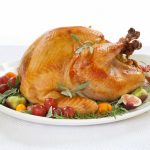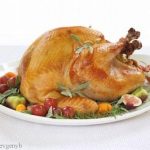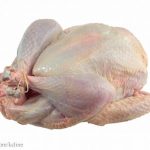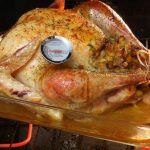There are only three safe ways to thaw a turkey and if you bought a giant, frozen bird your time has run out for one of them. Every year, The U.S. Department of Agriculture (USDA) compiles Thanksgiving food safety tips for consumers, including safe methods for thawing. There are three of them: refrigerator, cold water and microwave. To thaw a frozen turkey in the refrigerator, put it on a tray that can collect any juice and place the tray in a fridge with an internal temperature of 40˚F or lower. Allow 24 hours for every 4-5 pounds. So, a 4 to 12 pound turkey needs one to three days, a 12 to 16 pound turkey needs — three to four days, a 16 to 20 pound turkey needs four to five days and a 20 to 24 pound turkey needs five to six days A fridge- thawed turkey can stay in the fridge one … [Read more...]
Frying a Turkey for Thanksgiving? Watch Out!
If you're thinking about frying your turkey for Thanksgiving, the National Fire Protection Association says that outdoor gas-fueled turkey fryers that immerse the turkey in hot oil are dangerous and should not be used. The fryers "pose a significant danger that hot oil will be released at some point during the cooking process," according to the organization. The NFPA encourages consumers to use a new type of "oil-less" turkey fryer. Tests on these fryers shows that hot oil can splash or spill at any time while the turkey is frying. While older fryers that use a stand can collapse, newer countertop units with a solid base "appear to reduce this particular risk." But NFPA doesn't think that consumer education alone can make the risks of deep frying a turkey acceptably low. The large … [Read more...]
Thanksgiving Leftovers and Food Safety
The USDA is reminding consumers that turkey leftovers should be frozen after three or four days in the refrigerator. That means if you have any turkey left over from Thanksgiving dinner, it should be in the freezer by Monday. Correctly refrigerating all leftovers is critical to preventing foodborne illness. The bacteria in food left at room temperature for more than two hours double in number every 20 minutes. And some bacteria produce a toxin while they are growing that isn't destroyed by heat. Leaving food out at room temperature is one of the main causes of foodborne illness. It's also important to cool food rapidly to below 40 degrees F. Large amounts of food (such as the turkey) should be divided into smaller pieces and refrigerated as soon as possible. When you're storing other … [Read more...]
Happy Thanksgiving!
For everything you need to know about cooking a turkey, the Turkey Federation has the answers. Visit their site for information about temperature checks, stuffing, preparation, oven roasting, deep frying, and grilling the bird for your holiday celebration. They also offer information on safely storing leftovers and have lots of recipes too. The USDA has great advice for your holiday meal too. What should you do if your guests are delayed and you have to hold food? What should you do with the food if bad weather keeps company away from your holiday table? Or what should you do if a turkey is done hours before you're ready to serve? Get answers at the USDA blog. And remember that Ask Karen is available 24/7 at AskKaren.gov. And the USDA Meat and Poultry Hotline is available today from … [Read more...]
Turkey Stuffing Food Safety
The USDA offers food safety information for your Thanksgiving turkey stuffing. Their fact sheet is full of questions and answers all about how to safely prepare, cook, serve, and handle stuffing. The mixture of bread crumbs or cubes, seasoning, eggs, broth, and fruits or vegetables is called stuffing when baked inside the turkey, dressing when cooked in a crockpot or baking dish. It's also called filling. Stuffing is an excellent medium for pathogenic bacterial growth. Never prepare stuffing ahead of time; you can mix the wet ingredients and dry ingredients separately, but don't combine them until you're ready to cook. The stuffing should be moist because heat kills bacteria more easily in a moist environment. Never stuff the bird until just before it goes into the oven. And cook … [Read more...]
Is Pink Turkey Safe?
When you cook your Thanksgiving, Christmas, or Easter turkey, you want to be sure it is properly cooked and safe to eat. Sometimes, when you slice into a turkey, the meat will appear pink. Since we are cautioned to cook poultry until no more pink is visible, juices run clear, and the meat is at least 165° F, what's going on? The USDA has prepared a fact sheet called "Is Pink Turkey Meat Safe?" Many people calling the USDA Meat and Poultry Hotline with this problem. Here's the answer: the color of cooked poultry is not always a sure sign of safety. That's why a food thermometer is always recommended. Turkey can still be pink even if it is properly cooked. Remember that smoked turkey is always pink. Poultry is lighter in color than beef because it has much less myoglobin, the … [Read more...]
Holiday Food Safety Success Kit
The Partnership for Food Safety Education has put together a Holiday Food Safety Success Kit to help you make your Thanksgiving and holiday meals safe and delicious. Cooking the turkey is the biggest chore on Thanksgiving day and the one most fraught with potential peril. Thawing a frozen turkey can be complicated. A bird that is 15 pounds will take 3 to 4 full days to thaw in the refrigerator - longer if you keep your fridge at 35 degrees F. Never thaw a turkey on the counter. For more details, please see our post on Thanksgiving - The Big Thaw. But a fresh turkey should be purchased one or two days before Thanksgiving. There are several methods for cooking a turkey safely. Cook it according to charts for stuffed and unstuffed birds. Make sure your oven is accurate. Remember that … [Read more...]
Thanksgiving: The Big Thaw
Thanksgiving is this Thursday; are you ready? If you purchased a frozen turkey, it should already be thawing in your refrigerator. The USDA offers food safety information for thawing poultry. Never ever thaw meats at room temperature. As soon as any part of meat gets warmer than 40 degrees F, bacteria will start to multiply and grow well before the interior thaws. Remember that the "danger zone" where bacteria grow rapidly is between 40 degrees and 140 degrees F. It's almost a guarantee that there will be pathogenic bacteria on the turkey you buy. For refrigerator thawing, you need at least one day for every five pounds of weight. Make sure that you know where your refrigerator is coldest and warmest for best results. Foods take longer to thaw in a fridge that is set at 35 degrees F … [Read more...]
A Safe Holiday Feast
FightBac.org and Eat Turkey are offering a new Thanksgiving food safety infographic. When you're cooking and handling so much food on this typical American holiday, you need to be extra vigilant about food safety. Most likely your holiday guests will include those in high risk groups, including small children, the elderly, pregnant women, and those with chronic health ailments. And as always remember the four basic rules of food safety: Clean, Separate, Cook, and Chill. Wash your hands and any surfaces that come into contact with food often. Don't cross contaminate; separate cooked food from raw food and avoid using the same utensils, cutting boards, and plates for cooked and raw foods. Always cook foods to a safe internal temperature. Never serve undercooked ground beef, chicken, … [Read more...]
‘Ask Karen’ Offers Help for Thanksgiving Meal
The USDA is reminding consumers that 'Ask Karen', the food safety app offered by that agency, can help you make a safe Thanksgiving dinner. In addition, the USDA Meat and Poultry Hotline (1888-674-6854) offers bilingual help. Ask Karen has a searchable database of almost 1,300 questions submitted by consumers, along with the answers. The app is available in English and Spanish. Dr. Elisabeth Hagen, USDA Under Secretary for Food Safety said, "a delicious meal is the centerpiece of the Thanksgiving holiday, and USDA wants your meal to be as safe as it is enjoyable. Through the Ask Karen app and the Meat and Poultry Hotline, the USDA can help with food safety questions right when and where you need answers." The Hotline is open between 10:00 am and 4:00 pm ET on weekdays. It also offers … [Read more...]









